
Argentina is the 8th largest country in the world covering most of the southern parts of South America.
Following three centuries of Spanish colonisation, Argentina declared independence in 1816. Since then it has grown to a nation of almost 46 million people.
Buenos Aires is the capital with around 1/3 of the population (15.6 million) living there.
And it is the birthplace of the Tango.
It’s no secret that Argentina is famous for its love of football (soccer). The two most famous of these have to be Diego Maradona and Lionel Messi who were both born and raised in Argentina. They are both treated like heroes and everywhere you go you will find shirts with either of their names or faces plastered all over them. Importantly, Argentina also has a more than competent Rugby Union team.



Argentina is famous for its excellent wine and food, as well as music and dance. It is the fifth biggest wine producer in the world, but 90% of its production ends up never leaving the country.
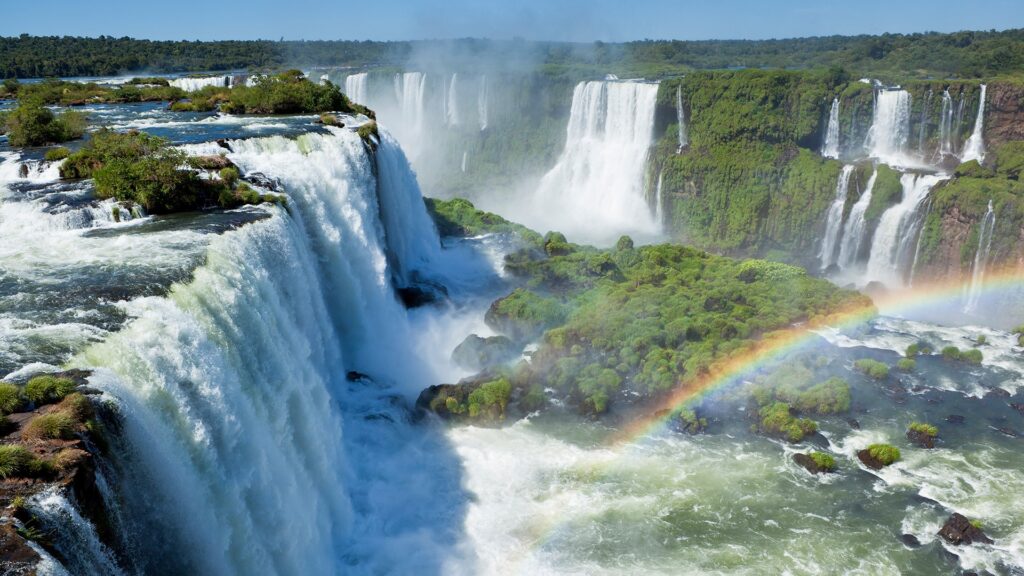
Iguazú Falls are on the border between Argentina, Brazil and Paraguay. It’s an incredible natural attraction with 450 bird species, 80 mammal species and an array of water fauna, some of which are currently endangered. Over one million people visit these falls each year, all things being equal, we will be two of these this year.



Despite the Victoria (Zambia/Zimbabwe) and Niagara (USA/Canada) Falls being more famous than Iguazu Falls, the Iguazu Falls are taller than Niagara Falls, and wider than Victoria Falls. This quite possibly makes them the most awe-inspiring falls in the world.
Argentina for us will become a bit like Malaysia is in Asia, and that is a central travel hub. We will be popping in and out of Argentina regularly while also exploring broadly wherever possible.
Currency in Argentina
Usually when travelling the use of credit or debit cards is the king. In every country, using a money exchanger at the airport (Travelex comes to mind) is almost always the worst and most expensive way to exchange your money. In some nations where cash is preferred (notably in Asia) getting the cash is usually best done from an ATM and then spent in the small stalls and trinket shops that deal solely in cash.
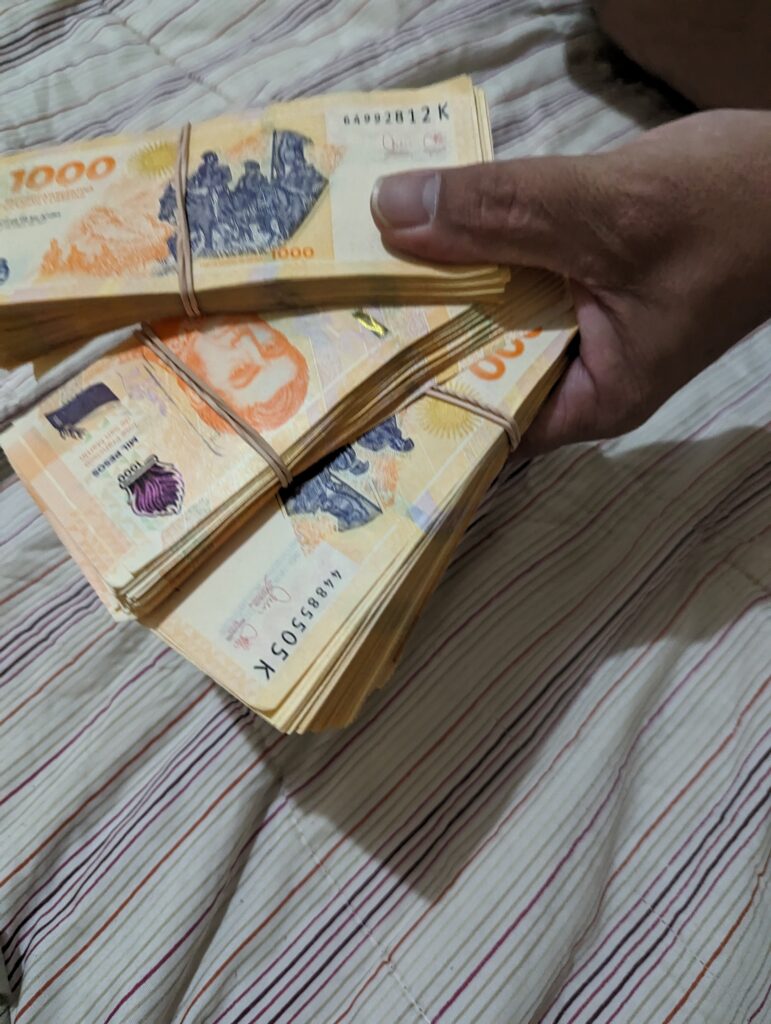
But not in Argentina. In Argentina there are two rates of currency exchange, the official one (where $1USD=827AP) and the black market one.
The black market rate is much higher (20-25%) and often changes based on the type of bill you swap out (eg a $50 bill will change at 940 while a $100 will change at 980).
This rate goes up the further you move away from Buenos Aires too. I got 940 in Buenos Aires but got 1050 on day one in in Puerto Iguazu and 1102 on day three (all considerably better than the official rate in the low 800’s).
This means that a meal for two costing 50,000 pesos (a very expensive and lavish meal with drinks) would cost you $93 Australian if you paid by credit card or only $69 Aussie if you paid cash.
Sadly, the bank notes come to you in 1000’s. So changing out money on the streets sees you walking around with huge wads of essentially $1 bills.
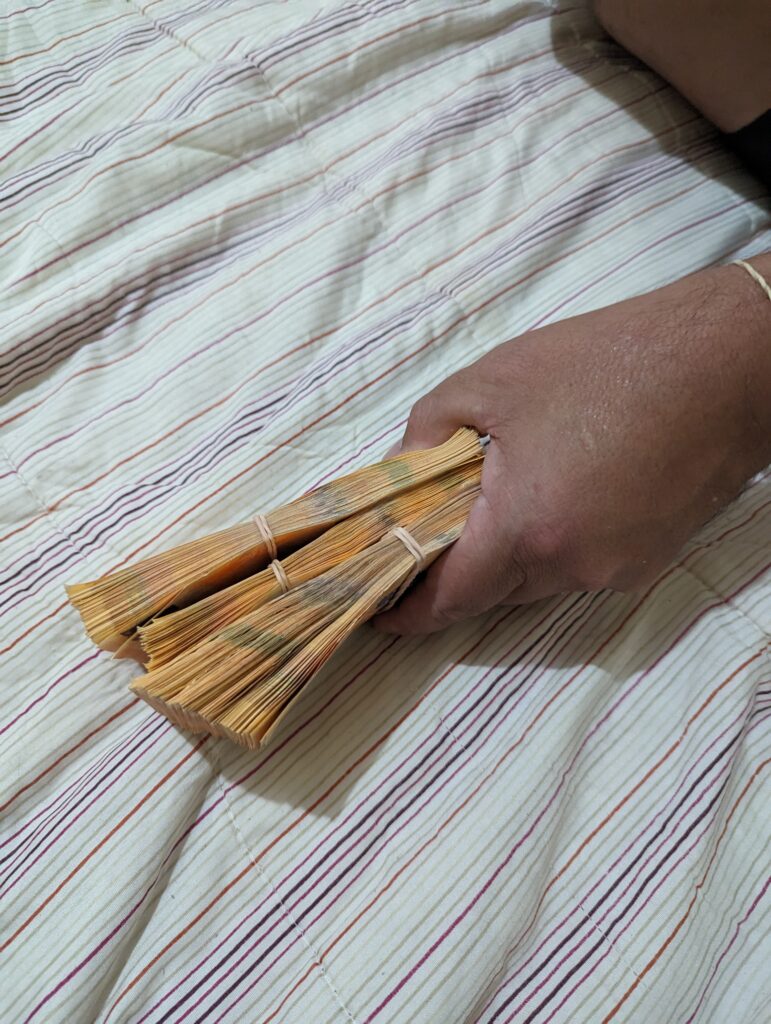
The Argentine economy is almost single-handedly ensuring the future of the rubber band industry.
Buenos Aires
Buenos Aires is the capital and main city of Argentina. The city is located on the western shore of the Río de la Plata, on the southeastern coast. “Buenos Aires” is Spanish for “fair winds” or “good airs”.
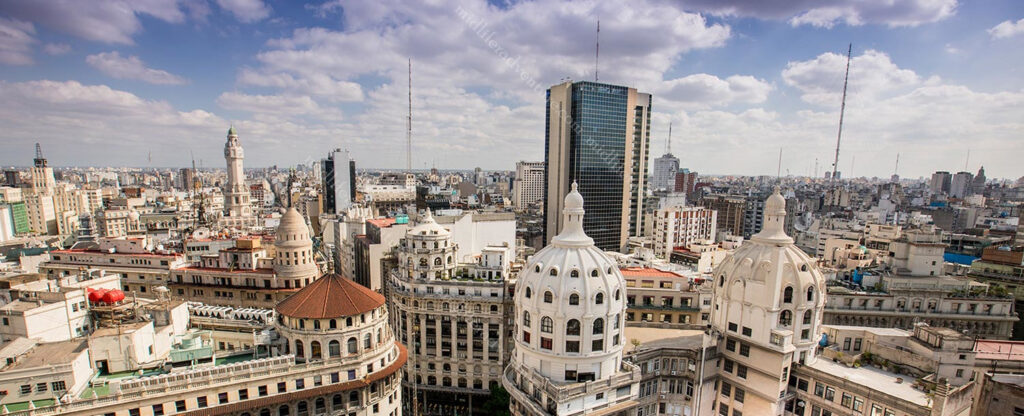
According to the blurb it was the Spanish coloniser Pedro de Mendoza (in 1580) that established the first settlement there, which he named Nuestra Señora Santa María del Buen Aire (“Our Lady St. Mary of the Good Air”). Buenos Aires locals are referred to as porteños (“people of the port”) because so many of the city’s inhabitants historically arrived by boat from Europe.
Our arrival into Buenos Aires was similar to those, and we came in through the port. We were just one of several ships in that day, and to say that the port was bedlam, would be an understatement. We had teamed up with our dinner buddies (Kurtis and Mark) who had a thing for gardening, so we got out of the port and Ubered our way to the botanical gardens (for about $4).
















I am much more a statue guy than a garden guy, and the photos clearly reflect that. That said, the gardens were nice, with the exception of the mosquitos that absolutely loved by high quality Aussie blood. There were trees aplenty and even a butterfly garden buried among all of the foliage.
To say that Buenos Aires is a dog friendly city would be an understatement. The sheer number of dogs in public parks and on leashes wandering the city was astounding. And these pooches are seriously pampered.



Sadly the wealth and influence of the city far overshadows the rest of the country. But as with all cities Buenos Aires also reflects Argentina’s economic and social problems. Homelessness and drug use were evident, although at no point did we feel unsafe or uneasy.
After the gardens we found a few little holes in the wall that fed and watered us for a ridiculously cheap price. Jill and I had 3 empanadas each washed down by a pint of the local brew (and a sampling of some others – including an on tap gin and tonic) for the princely sum of $8.40. After that we found a local deli and then a bakery, damn I think I might be falling in love with Argentina.








One of the major attractions of the city is the Recoleta Cemetery. In 1822, the former garden was turned into the first public cemetery in Buenos Aires. Known as the “city of the dead” or “city of angels”, Recoleta cemetery has a layout similar to a city with one main street, diagonals, narrow corridors and internal passageways.



It is set in an area of 5.5 ha (14 acres) and you will find around 4800 vaults and mausoleums. The cemetery is more of an open air museum than anything else. As soon as you walk through the doorway you are met with amazing architecture, works of art and sculptures.






More than 20 presidents, 25 city mayors, 40 governors, Nobel prizes, writers, politicians, engineers and even a caretaker are buried at Recoleta cemetery. But the most famous is that Recoleta Cemetery is the resting place for María Eva Duarte de Perón (known as “Evita”).
Outside the cemetery is a park known as Intendente Torcuato de Alvear. This area turned into a huge market on day two of our exploring.





Plazoleta Chabuca Granda (the oldest tree in town) also sits in the square outside the cemetery. It even has a statue of a dude holding up one of the super heavy branches.

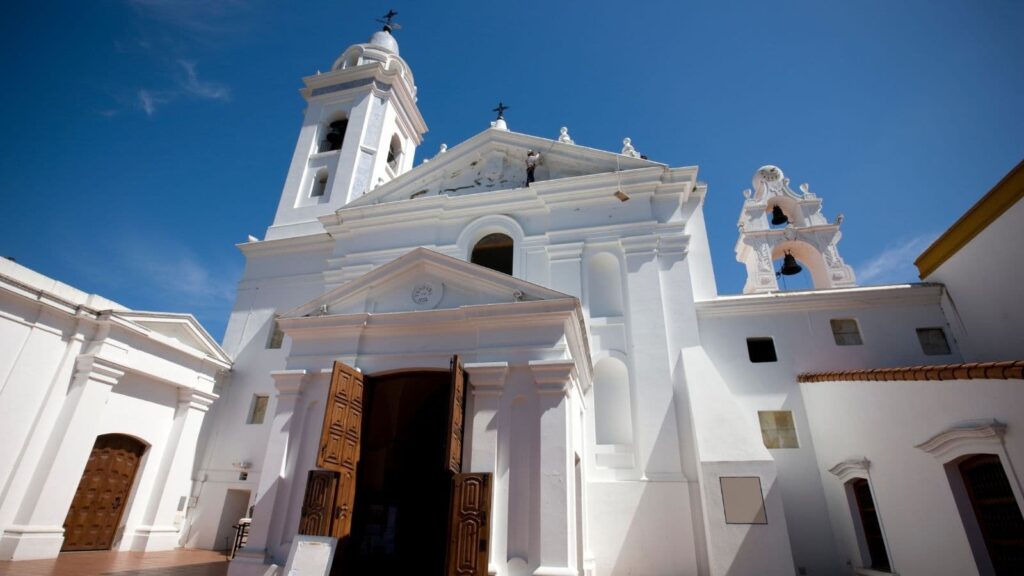
Just next door to the cemetery you can find the Nuestra Señora de Pilar church. Built in 1732 it is one of the oldest in the city.
In reality I got a bit turned around when exploring here. On day one we were at the cemetery and on day two we were at the Nuestra Señora de Pilar church (to follow). In reality these are side by side but I entered and exited the cemetery from the same way and did not even realise this. The next day we came at it from the opposite side and took a photo of the church that I had almost sat on the steps of the day before.
Buenos Aires is an amazing city with wide avenues and a true cosmopolitan flair that feels more European than Latin American. There are some huge colonial landmark buildings but the real feel of the city is the differences between the individual neighbourhoods. Each one has its own distinct feel and have their own meeting places, generally coffeehouses or bars.
At night Buenos Aires’s nightclubs (boites) come alive as people flock together to dance the tango.
This famous dance originated in the lower-class areas of the city and is said to ‘reflect the soul of the Argentina’.
While we didn’t go to a tango club, the ship did bring some of the best dancers on board that evening to put on a show.

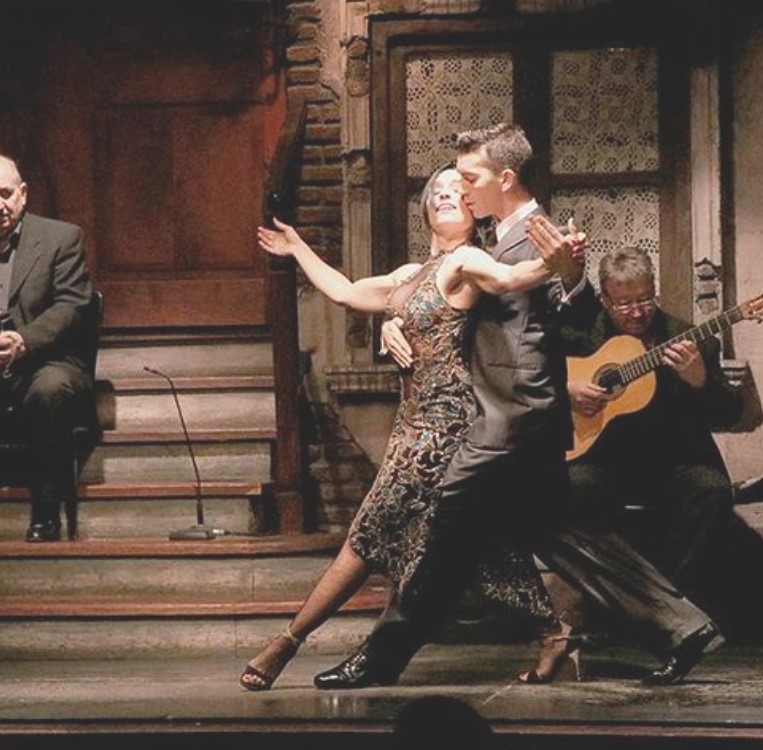
If you want to do the full tourist thing there are any number of these boites that will offer you dinner and a tango show.
But in reality, if you wander about a bit at night, you almost cant help but run across random tango breakouts.
As we were in town for two full days and day one was taken up with gardens and the cemetery, day two saw us hitting the major sights and the neighbourhoods. Lets say up front, two days was not enough. But it was what we had, so we hopped a cab ($5) to Plaza de Mayo which is the oldest public square in Buenos Aires.



The square is named after the Argentine revolution, which began on 25 May 1810. It has been the scene of many of the most important events in the city’s history, from the second founding of the city in 1580, through the revolution of independence, to more recent political demonstrations.
Around the square are several important buildings: the Cabildo (old town hall now national museum), the Metropolitan Cathedral (where Pope Francis conducted mass for 20 years), the Casa Rosada (Pink House or Presidential Palace and site where Evita gave some of the more famous speeches), the national revenue office, the national bank and the intelligence secretariat.






As a random bit of knowledge, apparently, they used to do a version of running of the bulls in the square, prior to the revolution.
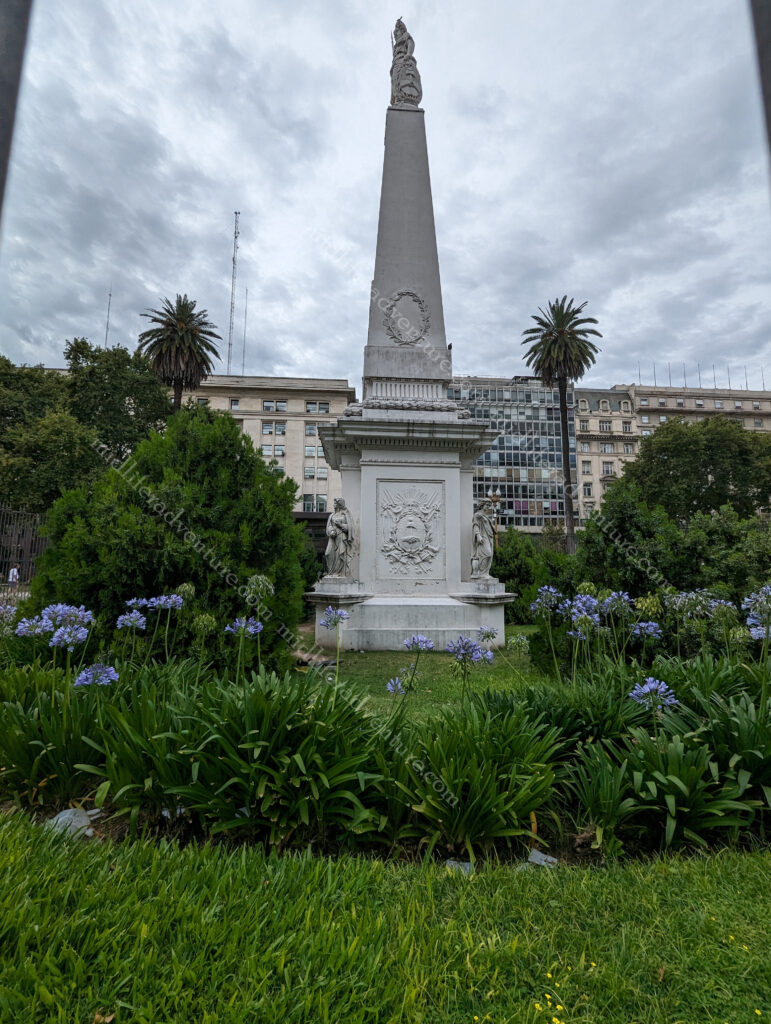
The Pirámide de Mayo is at the hub of the Plaza de Mayo and is the oldest national monument in the city.
It’s construction was ordered in 1811 to celebrate the first anniversary of the May Revolution.
It was renovated in 1856 and in 1912 was moved 63 metres with the idea that a much larger monument would eventually be constructed around it.
Having done the plaza we walked past the bank and along one of the many parks to explore the city more fully. We wandered along wide avenues and took in the interesting mix between the old and new parts of the city.










La Boca is a colourful neighborhood of Buenos Aires that is characterised by the street artists, narrow streets and brightly painted buildings. In the middle of La Boca is Caminito, a narrow alley flanked by zinc shacks that reflect the district’s early immigrant days. Caminito is more of a street museum than a traditional alley and the area gathered significance as the inspiration for the music for the tango “Caminito (1926)”.




Asado is the term used for South American barbecue. This type of meal is common in Argentina, Chile, Paraguay, Peru and Uruguay and usually consists of beef, pork, chicken, chorizo, and morcilla (blood sausage). These are cooked on an open fire or grill (called a parrilla) and usually eaten with side dishes and red wine.



Buenos Aires is the city with the highest number of football stadiums in the world. The city has at least 18 professional teams, and the passion for the sport is visible on almost every street corner.




The passion of Argentine football fans is legendary creating an electric atmosphere at each game. The fans choreograph chants, design tifos (giant displays), and ignite the stadium with their undying passion. When doing some research I found the following “Argentine football stadiums are not just structures made of bricks and cement. They are temples of passion, history, and culture. Each corner echoes with tales of legendary matches, iconic goals, and unforgettable moments. Every seat has witnessed emotions ranging from the ecstasy of victory to the heartbreak of defeat.”
How can you really argue with that.
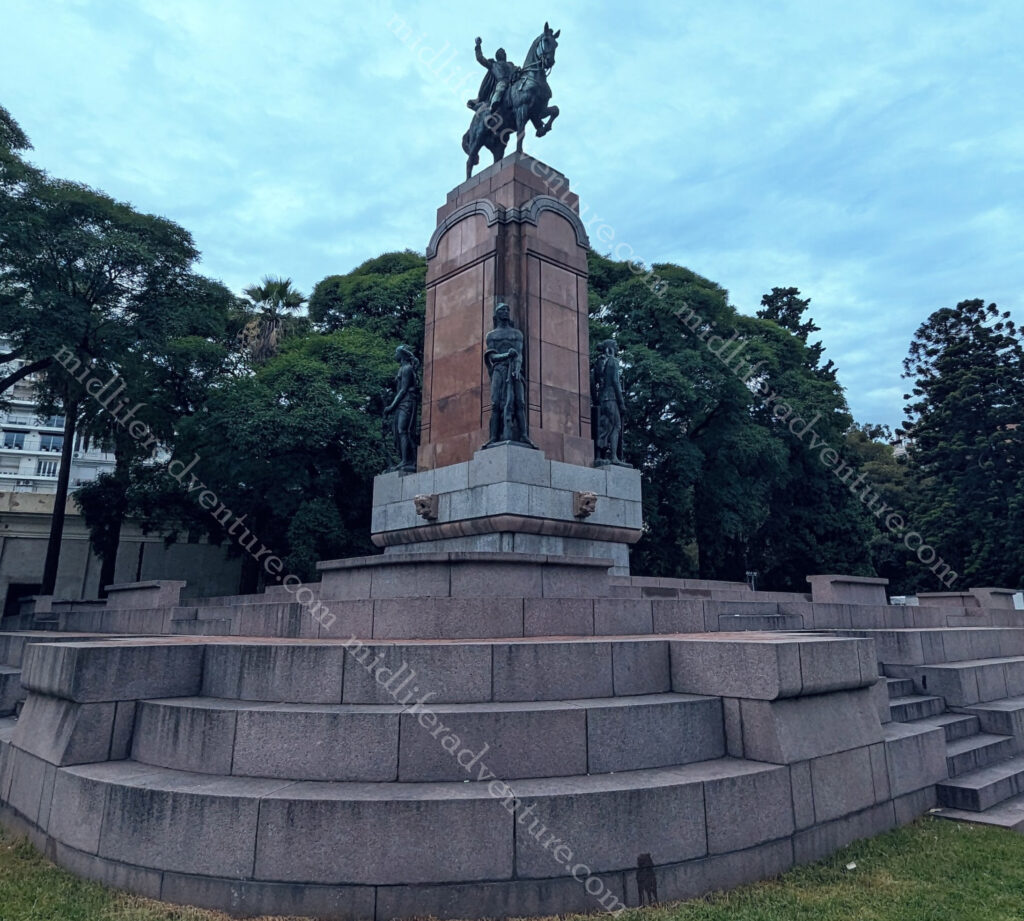
Our last part of the day involved a run down the hill from the cemetery past the Recoletta, through the park (and the market), past the statue in honour of Carlos María de Alvear a military revolutionary (and the towns first mayor).
Across the bridge, through the park, past the bizarre statues of kangaroos and to the massive law school building. I tried to get the story behind why there were kangaroo statues in Buenos Aires but had absolutely no luck.






We didn’t get here but in the Parque Tres de Febrero you can find the 1960s-built planetarium. Looking like a UFO it has projection room with a 20 meter dome and reclining seats for viewing projections of the stars.
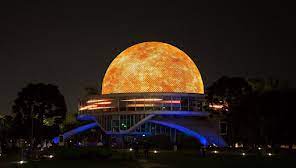
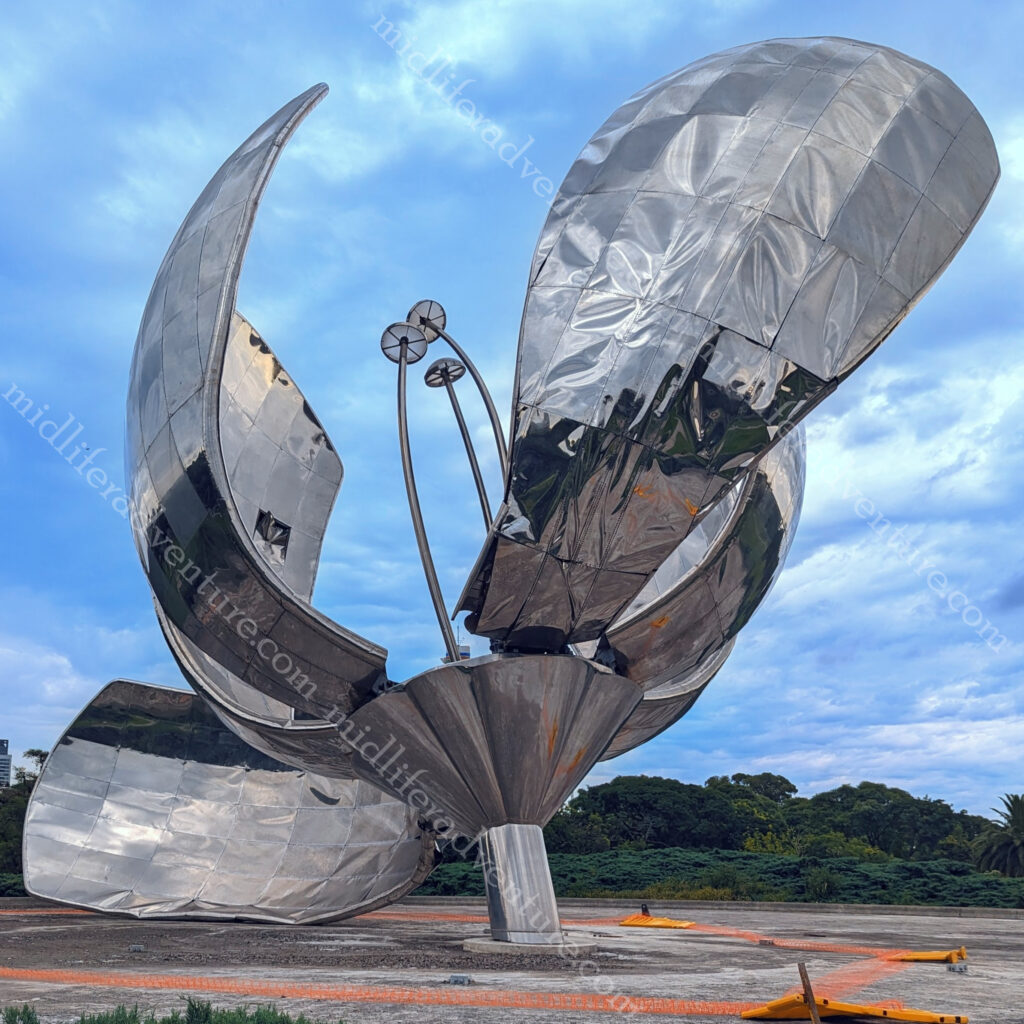
And our final port of call before heading out of town was to the Floralis Genérica. This is a sculpture made of steel and aluminum located in Plaza de las Naciones Unidas (United Nations Plaza) that was donated to the city by the Argentine artist.
Buenos Aires was amazing. It was neat, clean, friendly and extremely cheap. Meals, taxis and Ubers were all incredibly cheap and we have already decided that we will be coming back here many more times.
Buenos Aires – Mark II
Leaving Perto Iguazu on a 40-degree day had seen us sweltering all day with no access to our air conditioning and a 6 pm flight. We had hiked the falls on both sides with temps around 37 degrees but on the day we left it really cranked it up. Anyway, we were out and on our way back to Buenos Aires. Having blitzed it pretty well last time around we thought we could just kick back and enjoy.
How wrong were we. For all that we had seen there was so much more that we missed. This became painfully obvious when we (finally) got to our Air B&B apartment (more about the finally comment in a minute) and found that this was a whole section of town that we had missed (Plaza del Congreso). Jill had us booked in to a stunning little studio apartment right in the heart of town.
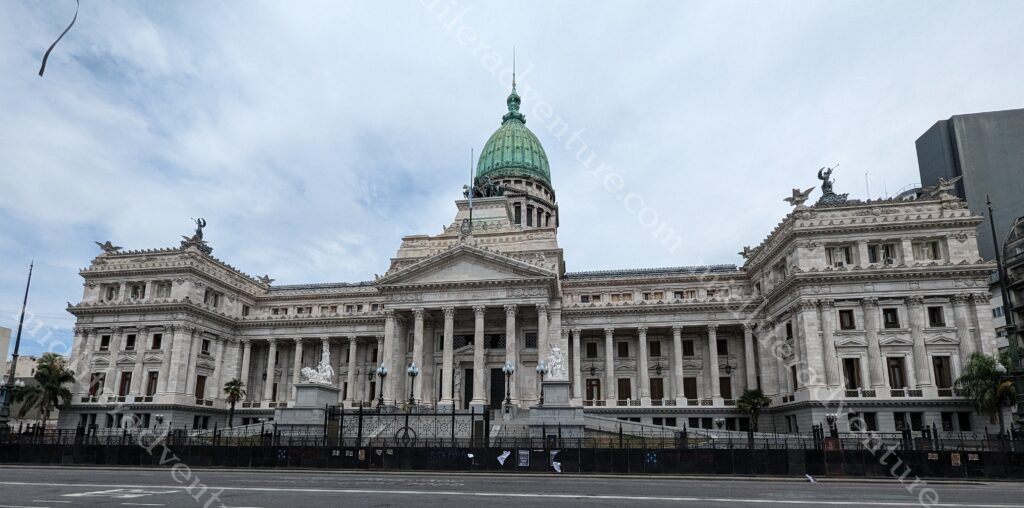
So we hopped off the plane, grabbed our Uber ($8) to the apartment and all was going swimmingly until we were about 650 meters away from it. When we tried to turn right, there was a motorbike policeman blocking the road banning access.
Now we have been using a learn Spanish App called Duolingo which has been great and has taught us some great stuff. I can now identify a green dress (la vestido verde) but needless to say that the content of the following conversation was not covered in our learn a language app.

In conversations with our Uber driver and later the motorbike cop we found out (with the help of live translate apps) that apparently there was a major demonstration that had turned into a riot, right in front of our accommodation. The protestors were throwing rocks at police and the police were responding with rubber bullets and water cannons. We were told that it was being dealt with and to grab a coffee or a meal and when the bike moved then it would be safe to head to our apartment.
Needless to say, the language app did not cover this level of detail. The news the following day had the photos below.








So we found a restaurant, had a couple of (one litre) beers a steak, a quarter chicken and some unplanned but delicious calamari all for about $33.



After the feed we headed out and the cop was gone, so we lugged our bags the other 650 meters to the site of riot. Along the way the local council was out with water blasters and leaf blowers cleaning up the streets and within around an hour you could barely tell anything had happened. By the next morning, apart from a few stray rocks, all evidence of a protest was gone and the Plaza del Congreso was back to being a tourist mecca.







The temperature in Buenos Aires was also in the mid-high 30’s and hiding in the air conditioning seemed like an awesome option. But breakfast awaited. So I hunted about and found a place just to the side of the congress building (scene of the riot) for three coffees, a smoothie and a couple of croque madame’s (under $16).



Argentinian Economic Crisis
Argentina was once a booming and brilliantly functioning first-world nation and remains a member of the G20. The infrastructure that is here and the efficiency of the systems reflects this. It is the second-largest economy in South America but decades of economic mismanagement, has placed it in an economic crisis.
Argentina nosedived into economic crisis in 2018 and has never fully recovered. Annual inflation has been above 50% most of the time since then; it reached 103% in February. This has resulted in soaring inflation and a booming black market for American dollars.
Since the 1950s, Argentina has spent more time in recession than almost any other nation, according to the World Bank. Nearly 40% of Argentines live in poverty, compared to about 25% at the start of the crisis. Between 1989 and 1991 Argentina experienced hyperinflation when it surpassed 3,000%, until they defaulted on their debt.
Recently the central government borrowing has gone from $63 billion to over $140 billion. The government has been introducing increasingly harsh austerity measures in the country. This has included spending cuts and privatisation which have been increasing interest rates, reducing employment, and massive devaluations in the peso.
Argentinian Food
To say that meat is king in Argentina would be the most ridiculous understatement ever made. Barbeque (Asado) commonly known as parrilla is at the heart of this. It originated with the gauchos, or cowboys, who would subsist on the abundant cows dotting the country. You can easily expect to find beef, pork, ribs, sausages, blood sausages and sweetbreads hot off the fire.






Chimichurri is the national go to. It is a green salsa made of finely chopped parsley, oregano, onion, garlic, chilli pepper flakes, olive oil and a touch of acid, such as lemon or vinegar.
I have had it in Australia and never got what the fuss was about, but now I understand.


Provoleta is a dish of pungent, sharp, discs of the cheese, topped with chilli flakes and herbs, then grilled. The nearly melted cheese is served slightly caramelised on the outside while being gooey and smokey on the inside. Top it off with olive oil or chimichurri.
Dulce de leche (loosely translated as ‘milk jam’,) is a thick caramel, the result of condensed milk being slowly reduced until sweetened and sticky.
It is used in almost every desert and is amazing.
We had it in so many forms it wasn’t funny, and they were all good.


Alfajores is one of the uses for the Dulce de leche. They come in any number of ways but are essentially two melt-in-your-mouth biscuits with dulce de leche in between. Some are dipped in chocolate others are rolled in coconut, but they are all good.
Empanadas are not solely Argentinian, but having had them in multiple countries, I think that the Argentinian ones so far have been the best.
They are basically the south American version of pasties. They can be filled with virtually anything that you want.
The Argentinian ones I have had seem to have had the pastry to filling ratio right.
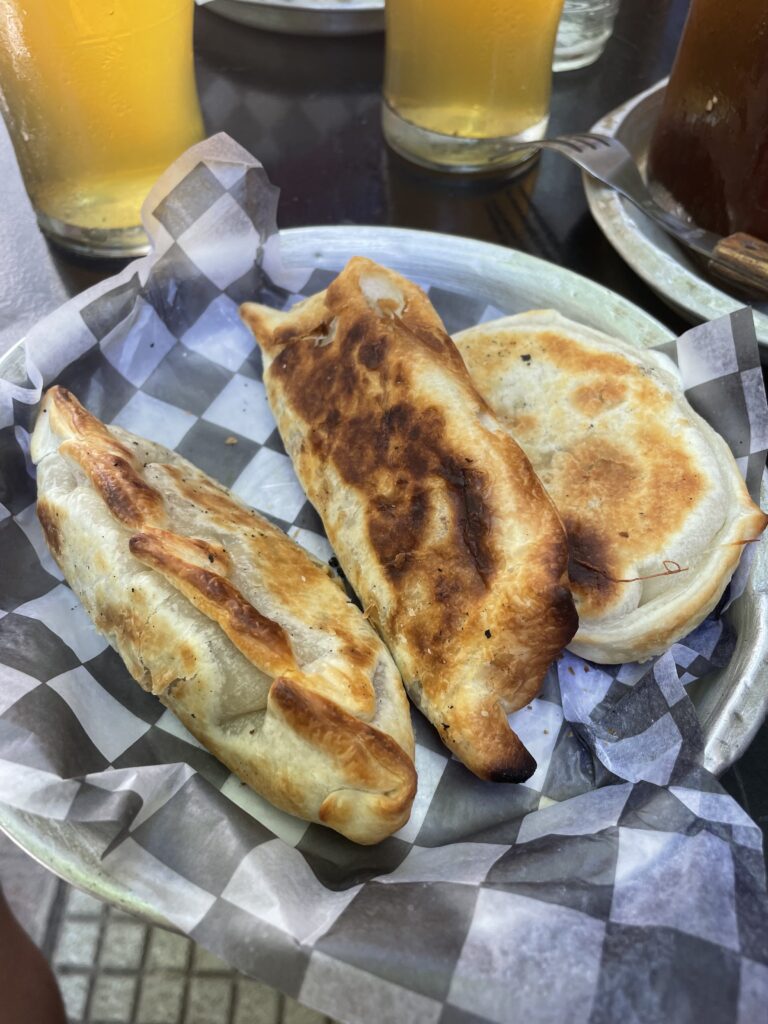

Yerba Mate is a local version of a herbal and caffeine type drink. It is everywhere.
Leaves from the yerba mate plant are dried, chopped and ground into a powder, or steeped, like tea as whole leaves into hot water.
It comes in little pots with a metal straw that doubles as a sieve. Not being a tea drinker, we never tried it, but it is absolutely everywhere you look, so there must be something going for it.
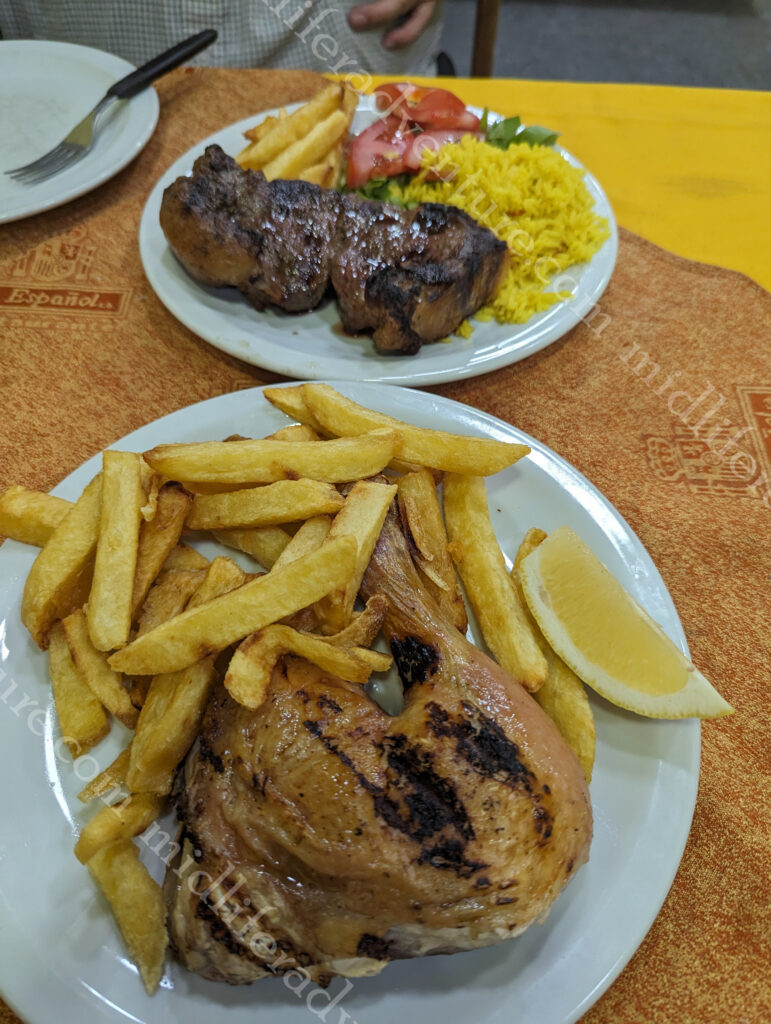
And of course, papas fritas or more commonly for us, chips.
These are everywhere, and come with everything. It is almost impossible to find any other type of vegetable.
This is truly the land of meat and carbs, maybe one of the reasons I have grown to love Argentina.
Puerto Madryn

Puerto Madryn is an Argentine city of a little under 100,000 on the coast of northern Patagonia. It is known for its sandy beaches and restaurant-lined promenade that faces Golfo Nuevo Bay. Between May and December each year, the bay is overrun by southern right whales that come to the bay to breed. In the late summer months, right whales come so close to land, you don’t even need a boat tour to see them.



Looking at the tourist blurbs, the main things to do (when we were there) was to check out the Magellan penguin colonies and swim with the seals. The prices for doing this from the boat were exorbitant so we chose to wander about instead.





As we wandered along the pier towards town we heard a barking sound, only to look down and see a bunch of seals resting on the steps and landings on the main pier. After wandering about for a few hours we checked again and the few that were there were joined by some friends and about 10 seals were kicking back on the platform.


Continuing to walk along the pier we got great city views and upon reaching the foreshore we were met with a wide beach stretching for around 3 km complete with seven set up beach resorts and free space in between.





The promenade is lined with statues, cafes, restaurants and bars. It is clean and safe with a really relaxing feel. There were markets set up (probably to relieve the cruise ship patrons of their funds) and there was even a couple of teenagers putting on a (very impressive) tango performance as a form of busking.









The thing that struck me most about the place was just how cheap it was. Everything that we looked at was very reasonably priced. We went to the grocery store to get some necessary items and in poking about found out that we could buy 1 litre bottles of beer for between $1.50 and $2.








As we headed around the corner I stopped for a haircut ($4) and then we settled into a little microbrewery for lunch and a couple of beers. The portion sizes were excessive but my steak sandwich came with bacon,egg, cheese, lettuce, tomato and a side of chips, while Jill’s burger required a jaw that detached. Huge meals coupled with two pints (each) and the bill saw us getting change from a $20. We even got unshelled peanuts while we contemplated our options.




While only small, this place was fantastic. Nothing was overpriced and the place just felt right. The more we see of Argentina, the more we like. Our shopping expedition saw Jill scoring a new singlet and satisfying her chocolate fix with a stockpile of Kit Kats for next to nothing. I even found the rugby shop.


I did some looking to see how much the accommodation costs were, given that everything else was so cheap. I found nice cheap hotels with beachfront views coming in in the mid 30’s and higher end options maxing out at about $100. I can absolutely see us coming back here and setting up camp for a week or two, especially when the whales are mating.
Ushuaia
Leaving Antarctica we started heading back north towards the South American mainland. As we did so however we arrived at the unpopulated area of Tierra del Fuego as our first landfall. Here we were met with a brutal, unforgiving and unprotected landscape that had a single lighthouse perched exposed to the elements.





High on the hill, up from the lighthouse is the Monument to the Albatross. The monument is a large sculpture featuring the silhouette of an Albatross in honour of the sailors who died while attempting to ’round the Horn’.
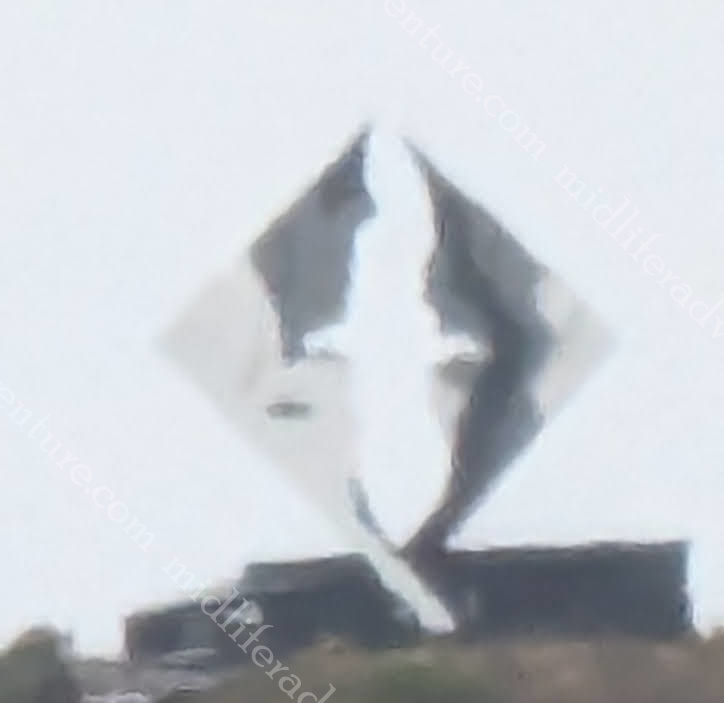
It has been estimated that 10,000 lives and 800 ships have been lost in this region alone.
It was erected in 1992 through the initiative of the Chilean section of the Cape Horn Captains Brotherhood.

From the outcrop we continued through the Beagle Channel past some of the most amazing arctic landscapes that you will ever find. We were headed west towards the southernmost city on the planet, Ushuaia, Argentina.



Ushuaia has a population of around 82,000 and sits below 54 degrees south latitude. The name is derived from a native word meaning “bay towards the end”. The city sits on the bay and is surrounded on the north by the Martial mountain range and on the south by the Beagle Channel.

The area had been inhabited by indigenous people for more than 12,000 years. It was first encountered by a European in 1520 when spotted by Ferdinand Magellan. Even after Argentina achieved independence, this territory remained under indigenous control until the 1870s. European immigration followed due to a gold rush and rapid expansion of sheep farming on large ranches in the area.






With so many maritime deaths and such hazardous wind and ocean conditions it is unsurprising to find a naval station in Ushuaia and a heap of statues dedicated to the lost souls of mariners who have perished in these waters.













The people are friendly and the welcome is authentic. A smallish town with some very odd choices of architecture, given the temperatures that are about. I was very surprised to see tiny little houses made of corrugated iron. Some had the steep roofs that you would expect but others just seemed out of place, especially when the Martial mountain range, with its snow-covered peaks, loomed everywhere.












Along with being the southernmost city on the planet, Ushuaia is known as the launching point for two main forms of adventure tourism. These are the many Antarctic Cruises (noting that only ships of under 300 people can get onto the ice) headed south and the many motorcycle tours headed north through Patagonia. So arrival here will see a bunch of both boats and adventure tourer motorcycles.


I must say that my original plan was to ride through Patagonia on motorcycles, but if this is the summer temperature, then I might rethink that plan. On the flat at sea level the wind is brutal and the temps are chilling. I can only imagine what they would be like on some of the windy and icy mountain passes.
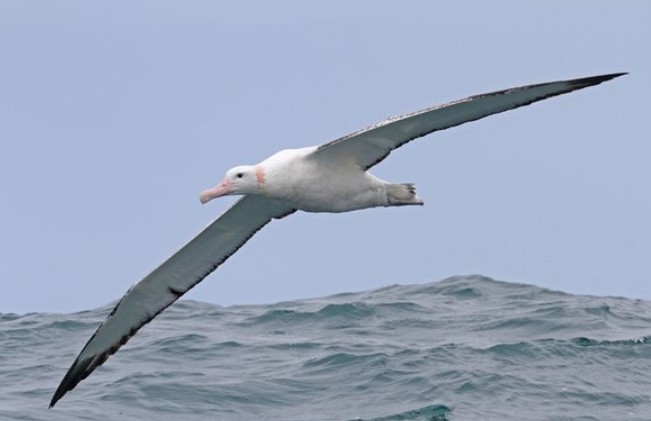
And of course, in this part of the world, you will see your fair share of albatrosses. With 11 foot wingspans, they are the master of gliding and picking up wind currents. We watched some soar for over 20 minutes without a single flap of their wings.
In the Beagle Channel, there are several small islands that are inhabited by a range of seals, cormorants and penguins. And there are tours operating daily that will happily take you out to get your fill of photographs.







As has become a thing for us, we took note of some of the very cool street art that is dotted around the town. It really is a way of adding interest to otherwise drab walls and when done well can be an attraction in its own right.










The refreshing thing for us about being in Ushuaia (as it has been throughout Argentina) was the pricing. Things are not obscenely priced. Being so remote we expected to be destroyed on the prices being charged but were very pleased to find that a beer could be obtained for as little as $1.50 and $10 would get you a meal as well.








For about $22 there was an all you can eat crab and lamb shack. The lamb was on racks, roasting over open fires while the smell and smoke filled the air. But having been on a ship, this sort of eating was unnecessary, even if incredibly tempting.




We were here in the height of summer and the place maxed out at about 8 degrees Celsius. This was a once in a lifetime style destination and while it was nice, I cannot see us making our way back here anytime soon.
Iguazú Falls – Foz do Iguaçu
Iguazú Falls or Iguaçu Falls (depending on which country you are in) are waterfalls on the Iguazu River at the border of Argentina and Brazil. The falls are taller than Niagara Falls (in Canada) and wider than Victoria Falls (on the Zimbabwe/Zambia border). It is truly one of the most impressive waterfalls in the world and lives up to all the hype.


Some context

The falls are on the tri-border of Argentina, Brazil and Paraguay, however there is no views of the falls available from the Paraguay side.
Foz do Iguaçu is the Brazilian town of the tri-national region, bordering the Argentine city of Puerto Iguazú and the Paraguayan city of Ciudad del Este. Our trip saw us having 2 days on the Brazil side and 3 days in Argentina.
The semicircular waterfall is a bit over 80 m high and 2,700 m in diameter and is made up of many cascades producing vast sprays of water, it is one of the most spectacular waterfalls in the world. At one point along the edge of Iguacu Falls, an observer can stand and be surrounded by 260 degrees of waterfalls.
Around 80% of the falls are on the Argentinian side, while the remaining 20% is on the Brazilian side. The falls are made up of 275 individual waterfalls that drop water anywhere between 60 to 82 meters (depending on what they hit on the way down). In the local language (Guarani/Tupi) the word Iguazu means “big water”.
The legend
And of course, like any great natural feature, there has to be a local legend to explain its existence. In this instance the serpent god (M’Boi) was considered the God of the waters, protector of the river, nature and son of Tupã, the God of the Indians. But M’Boi fell in love with a local girl (Naipi) who was already engaged. He demanded that instead of marrying her fiancé (Taruba), she be sacrificed to him.

They decided to run away but M’Boi chased them and in a rage sliced the river, creating the falls and condemning the lovers.
Eventually, he transformed Naipi into a giant stone and Taruba into a tree on the other side of the falls, so that they would forever be apart.
A rainbow often forms from Taruba’s tree on the Brazilian side to Naipa’s rock on the Argentine side, which is said to symbolise their love.
However, the Serpent God is believed to still jealously watch the lovers from one of the deepest parts of the river, which is also known as the Devil’s Throat. Approximately one million litres of water per second is known to flow over the falls at the Devil’s Throat (or Devil’s Cauldron).
The Argentinian side of Iguazu is way cheaper than the Brazilian side, for accommodation, food, drinks, ticket prices and tours. If we had known this differential beforehand we would have scheduled our visit considerably more different (but more about this later).
Our first meal in town was not our usual cheap and cheerful but a flash joint with table cloths and table lighting. The night before we had done the Brazilian BBQ and were in a meat coma and then we found the Argentinian Parrilla (basically the same thing but cheaper).






The next morning it was off to the falls from the Argentinian side. Thankfully this was much cheaper and much easier. Rather than the $400 that we paid the day before, we paid $52. This did omit the private driver and boat ride but included the bus rides to and from the National Park and all entrance fees.
Fair warning, the Argentinian side does have even more walking than the Brazilian side. But it is considerably flatter, with fewer hills, less stairs and is on better paths. There is a train to take you some of the way, but there will be much walking.










Iguazu Falls is one of the natural wonders of the world, and for good reason. Wandering its grounds is pretty special and the attention paid towards protecting the National park is excellent. As you head through there is a myriad of boardwalks, pathways, platforms steering you through and allowing you to discover the waterfalls pouring every which way, while also stopping the hoards destroying nature.
Bring a rainforest there are critters. So using the best of safety concerns the Argentinians have put up a sign that basically translates to…don’t be a dickhead.
The rest it up to you.
I am very ok with this sort of approach to stupidity.
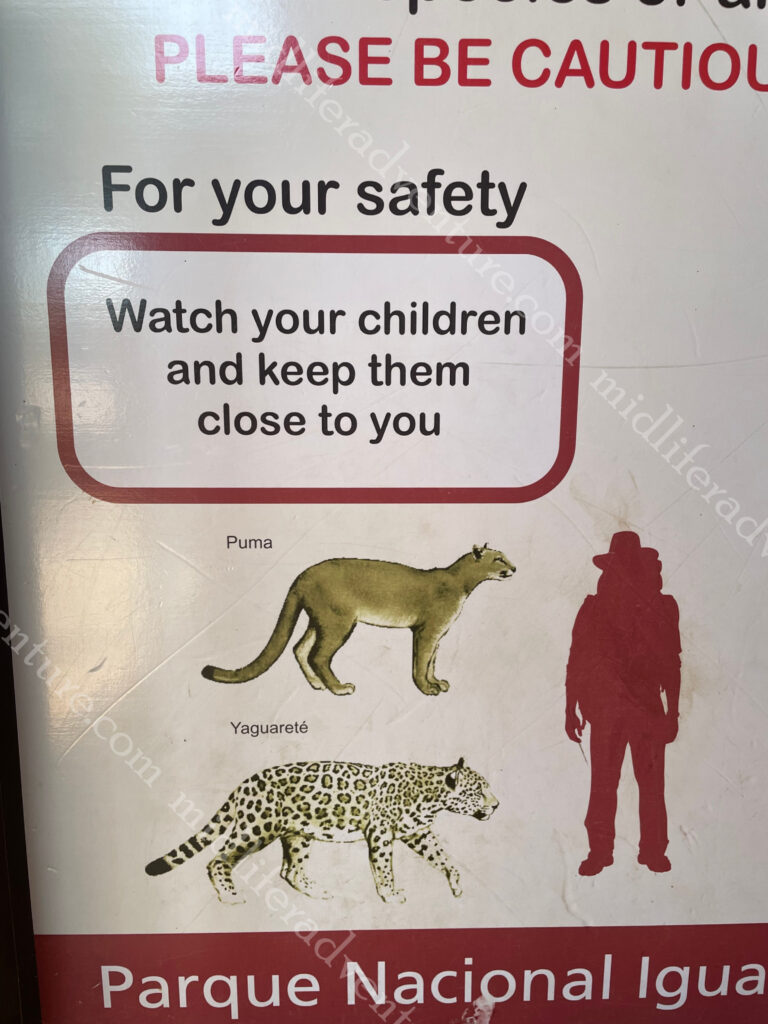
Because the Iguazu Falls straddles the border there are very different vantage points and views from either side. And all of them are gorgeous.










The Argentinian side has two main trails, the upper and the lower. There used to be an extra train stop that took you to the a platform above the Devil’s Throat but major rains and flooding took out the platform and it is unlikely to be reopened. The upper trail takes you up high and you get to see the top of the falls (which really isn’t that interesting as you see a cliff with water running over it).



The bottom trail however offers the best views with the water falling and cascading and the rainbows and all of those things that that you expect and come to see when you head to a waterfall.









After our blitz around the falls, we were off to another Parrilla for yet another meat fest. We really tried to order vegetables, but meat really is king here. My favourite part was that they served my 740ml beer in a high hat on ice. We got the mixes seafood entree and followed it with a 900gram tomahawk steak to share. While we may have been at a flash restaurant, my inner caveman came out and I gnawed upon that bone like my life depended on it. Something that my wife was more than eager to immortalise on film.







The best way to do it
Having seen the falls from both sides we felt that we were well placed to offer our insights and suggestions of how best to go about this if we were to do it again.
The bus transport from Argentina is efficient, reliable, clean, cheap and airconditioned. The Brazilian side however is woefully inefficient. But from Puerto Iguazu, there is also buses that will take in the Brazilian side without having to deal with buses taking off and leaving you to wait.


Point number one…you need to see both sides. It is amazing and every view is different and all angles are amazing. But the Brazilian side is absolutely the best, but it is also the most expensive (not prohibitively though so don’t be too scared). If you wanted the 5 star experience you could still do it on the Brazil side without destroying a budget.
So if we had our time over we would have stayed the 3-4 days on the Argentinian Side (saving money on both food and accommodation) and visited the Argentinian side first. We would have done the boat ride from the Argentina side, saved a ton of money and got wet at exactly the same falls.
The next day we would get up early and catch the Argentinian bus over to Brazil and do that side of the waterfalls. Over here you get better views (even if farther away) of 80% of the falls and you also get up close and personal with the remaining 20%.





But any way that you choose to see the Iguazu (Iguacu) Falls I am certain that you will not be disappointed.